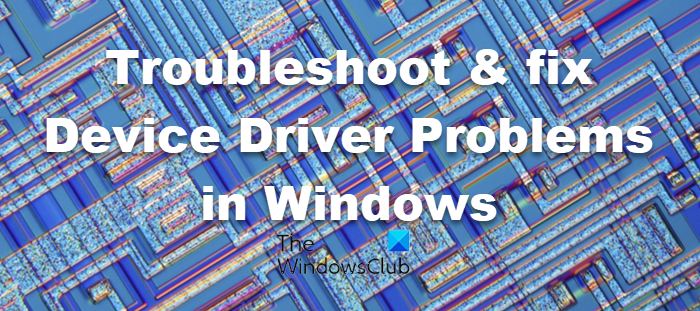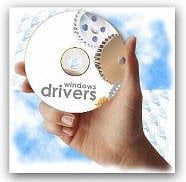Windows 11/10/8/7 has inbuilt driver support for a multitude of devices, but there are many hardware devices that require special drivers to work properly, and that’s why if the hardware that is installed in or attached to a computer doesn’t work properly, it’s often because of a driver problem. I have tried to provide solutions to some common driver problems.
Fix Device Driver Problems in Windows 11/10

You installed a new hardware device and it’s not working properly
- Make sure that the hardware device is compatible with your computer and with your version of Windows. If the device isn’t compatible, you will need to find the correct driver. Check the information that came with your device. You can also search for the device on the Windows Compatibility Center website. This website contains a comprehensive list of computers and devices that have been tested to work with Windows 7.
- Many devices require special drivers to work properly. Be sure that you have installed any software discs that came with the device.
- Restart the computer, restarting might be necessary if the driver requires it, or if the driver didn’t install correctly.
- If the device is a universal serial bus (USB) device, disconnect it and then plug it into a different USB port. Windows should detect the device and install the drivers and notify you if the device drivers didn’t install properly.
- Updated drivers might be available through Windows Update. When you check Windows Update, click View available updates to determine if an updated driver is available for your device. You may also check up on the manufacturer’s websites for updated Drivers.
My device used to work, but now it doesn’t

These are several things you can try!
- Updated drivers might be available through Windows Update. When you check Windows Update, click View available updates to see if an updated driver is available for your device.
- If you can’t find a new driver through Windows Update or the manufacturer’s website, try reinstalling the software that came with the device, which might contain drivers.
Read: How to install Drivers in Windows 11
You installed the latest device drivers using Windows Update, and in future you want it to happen automatically:
It’s important to set Windows to download and install updates automatically. But even if you have Windows Update set to automatically install important updates for your computer, it still might not be set to install all the updated drivers it finds for your hardware. To automatically get available driver updates for your hardware, set Windows to install recommended updates.
Related read: NVIDIA, AMD, Realtek drivers won’t install.
To set Windows to install recommended updates:
- Click to open Windows Update.
- In the left pane, click Change settings.
- Under Important updates, click an item in the list.You can decide which updates to automatically download and install.
- Under Recommended updates, select the Give me recommended updates the same way I receive important updates check box, and then click OK. If you’re prompted for an administrator password or confirmation, type the password or provide confirmation.
You can also allow anyone using your computer to install updates by selecting the Allow all users to install updates on this computer check box.

You can set Windows to automatically install important and recommended updates or important updates only. Optional updates aren’t downloaded or installed automatically. To get all available updates for your devices, periodically check Windows Update for optional updates.
You can also use Driver Verifier Manager & Device Manager to fix driver issues.
If you feel the need, you can refer to this post, to identify computer hardware problems.
Additional resources:
- List of Windows Device Manager Error Codes & their Solutions
- Identify computer hardware problems with Hardware Identify software.
I find that you NEVER want to install hardware driver updates from Windows Update.
With the tech calls I receive related to driver issues, about 60% of the time Windows Update has installed an incompatible driver and a rollback is all that is needed to fix the issue. This even more prevalent with regards to audio drivers.
Stick to the drivers from the manufacturer if possible.
Yea, Windows Update is unbelievable to automaticvally install needed drivers. Sometimes, you would be prompted that drivers can’t be installed rightly. I know a totally free program called DriveTheLife that can automatically ftind and install suitable drivers for your hardware.
Besides, it offers you with free drivers backup and restore. Try it if needed: http://www.drivethelife.com
Updating the Windows update regularly is important. After noticing certain issues and problems, I update the drivers and the necessary updates to resolve the issues.
Thanks a lot! the wrong realtek audio driver led to I can’t hear anything. I followed the instruction and uninstalled the latest driver by Driver Talent, then I installed a different version of realtek driver by it with one click. After reboot, yeah, I can hear. You are a genius.
Thanks was starting to get realy annoyed when my computer would lock up (it wouldn’t restart I had to crash it) because of that dang message. Dear, Microsoft make windows just shut up and work! I’m stick of pop ups, balloons, and stupid assorted messages just do your thing and let me finish what I’m doing, god.
On the positive side I’m glad windows 10 acts more like windows xp this has been the only annoyance so far. :)
So, how do you update a driver when you can sign in to your windows? It only works in safe mode with no Internet. This is the second time my sons PC has froze upon the log in screen. I thought the first time i fixed it something had changed his Boot line up. This time it is not working.